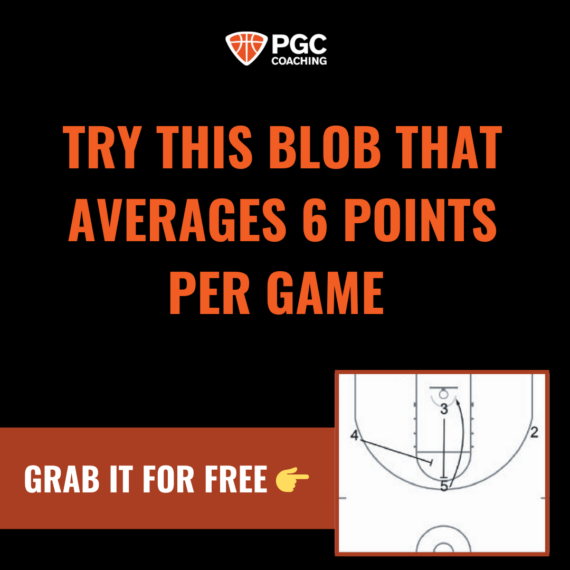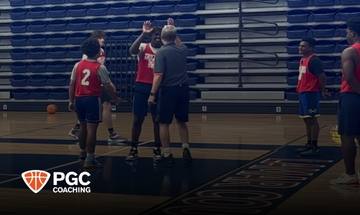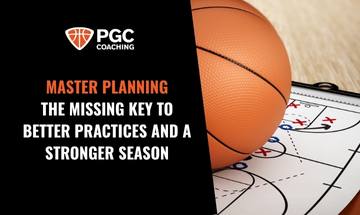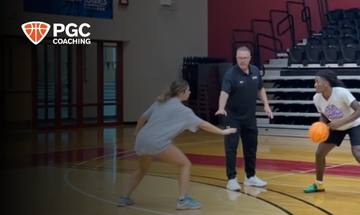How to Design Better Basketball Practices (Without Overthinking It)
There’s no one-size-fits-all formula for designing a great basketball practice.
But there are a few key elements you can’t afford to miss if you want your practices to consistently build winning habits.
I’m going to share three core ideas that shape how I approach every practice and I invite you to borrow them, tweak them, and make them your own…
But first, if you like these three ideas, you may also like the following resources:
- Master Planning: The Missing Key to Better Practices and a Stronger Season
- How to Execute a Great Basketball Practice
- Why I Spent 12 Straight Practices on the Read & React (and Didn’t Teach Defense)
1. Red, Yellow, Green Practice Design Strategy
Before we ever draw up a drill or set a schedule, we start by asking this question:
What kind of day is this?
We label our practices red, yellow, or green—and each color determines our intensity, focus, and flow.
- 🟥 Red Practice – These are low-intensity days. Maybe it’s the day before a game. Maybe your team’s legs are dead. So, we back off. We focus on skill work, five-on-0 actions, walk-throughs, and a ton of teaching. We stay in the half court, limit contact, and protect our players’ bodies.
- 🟨 Yellow Practice – These are middle-ground days. You’ll see a mix of coaching, teaching, and competing. We talk more, we explain more, and when we do go live, we go hard.
- 🟩 Green Practice – These are go days. High energy, high reps, full-court, and full-speed. We push the pace, we compete, and we get a ton of work done. These days are about maximizing reps and building toughness through repetition.
It’s a simple system, but it keeps our staff aligned and helps us manage the physical and emotional load of the season.
2. Build Arcs Into Your Practice Design Strategy
Next, we think about the flow of our practice. Not just what we’re doing, but how it builds. We call this creating an “arc” to your practice design strategy.
Sometimes that arc is practice-wide:
Maybe we’re building toward a 5-on-5 competition segment at the end. Everything leading up to that point—skill work, small-sided games, controlled drills—is setting the stage.
Other times, we build multiple smaller arcs:
- One arc focused on defensive positioning
- One arc focused on ball screen coverage
- One arc focused on transition offense
Each arc might follow a similar pattern: Teach. Learn. Compete.
For example, if we’re working help-side defense:
- First, we teach the positioning and footwork
- Then, we learn through live, controlled reps (maybe dummy D or half-speed)
- And finally, we compete—3-on-3 or 5-on-5 with real game-like pressure
This layered structure builds habits while keeping players engaged and moving with purpose.
3. Bake Competitiveness into Your Practice Design Strategy
Let me ask you this:
When your players show up for a game, can they figure it out on their own?
Because if your practices aren’t competitive…
If you’re holding their hand the entire time…
If they never have to think for themselves or make real-time decisions…
Then don’t expect them to magically do it when the lights come on.
That’s why we build competitive decision-making into every practice:
- Score it
- Track it
- Make it mean something
And when we evaluate our plan at the end of the day, we ask:
“Was this a competitive practice?”
Not just busy. Not just well-run.
Competitive.
Because ultimately, our players need to be problem-solvers. They need to be gritty. They need to learn how to win.
Bonus: Drills You Can Plug Into Your Practices
Whether you’re running a Red, Yellow, or Green day…
Whether you’re building a practice-wide arc or stacking a few mini arcs…
You still need great drills that fit the moment.
Below are a few of our favorites across key categories. Each one includes a link you can watch, borrow, and use right away.
Defense
- On-Ball Defense Habits – Teach your players how to control the first two dribbles and “guard their yard.”
Watch the On-Ball Defense Habits Drill - Bear Defense (2-on-1) – Help your players turn bad situations into defensive wins by protecting the “den” and forcing tough shots.
Watch the Bear Defense Drill - Jump, Mud, and Bubble Drill – Build defensive habits by teaching players to jump to the ball, get into the mud (deny driving lanes), and pop the bubble (pressure the ball). Emphasizes communication and rebounding.
Watch the Jump, Mud, and Bubble Drill
Shooting
- One-Minute 3-Point Shooting – A progressive challenge where players aim to hit 10 threes per minute and level up as they improve. Great for rhythm, footwork, and pressure shooting.
Watch the One-Minute 3-Point Basketball Shooting Drill - 7-Spot “Huie” Shooting – Make two in a row to advance through seven spots in two minutes. Great for building rhythm, range, and shot consistency under time pressure.
Watch the 7-Spot Basketball Shooting Drill - Crazy 8’s Shooting & Footwork – Maximize reps and efficiency while developing shot prep, footwork, and finishing at six baskets. Great for large groups.
Watch the Crazy 8’s Basketball Shooting Drill
Rebounding
- Defensive Rebounding Habits – Build the habit of hitting on the shot, high-pointing the ball, and reacting with urgency.
Watch the Defensive Rebounding Habits Drill - Rodman Rebound – Train players to secure one-handed rebounds, battle for the ball, and finish through contact.
Watch the Rodman Basketball Rebounding Drill
Passing
- Two-on-two Entry Pass Basketball Drill – Helps train your ballhandlers to pass against pressure. Also a fun game when you award points for different skills demonstrated.
- Serbian Basketball Passing Drill – Develop full-speed passing skills with cross-body, shuttle, two-hand, and behind-the-back passes—perfect for warm-ups and fast break habits.
- Wrap Basketball Passing Drill – Sharpen footwork, first-step quickness, and precision with this four-pass drill featuring air and bounce passes off both hands.
Finishing
- Wing Drive & Finish Basketball Drill – Train players to rip baseline, take contact, finish strong, escape with a Nash dribble, or sweep back to the middle.
- Barkley Series Basketball Finishing Drill – Train guards to bail out of drives, play in the post, and finish or spin out based on contact—plus escape if no advantage is gained.
- Mikan Series Basketball Finishing Drill – Build “goal comfort” with four types of rim finishes: one-foot, reverse, two-foot power, and Kyrie extension finishes.
- Comfort in Chaos: Basketball Finishing Drill – Train players to stay composed, shot-fake, and finish through chaos and double-teams with eyes to the rim.
Competitive/Game
- 4-on-4 Game Drill – Build competitive habits by connecting closeouts, shot contests, and box outs—all while hunting “plus-one” great shots.
Watch the 4-on-4 Competitive Game Drill - 45 Scramble Down – Sharpen defensive communication, scramble coverage, and down screen defense before finishing with a live 5-on-5 segment.
Watch the 45 Scramble Down Drill
Final Thoughts
There’s no perfect way to design a practice. But if you start with these three ideas…
- Red, Yellow, Green system to manage intensity
- Arcs that guide your flow and build learning
- Built-in competitiveness and decision-making
…you’ll begin to design practices that develop confident, adaptable, game-ready players.
If you’d like to explore even more resources just like these, grab a free 7-day trial to get access to our members-only content.
– TJ
Check more practice planning and execution resources here.
About the Author
TJ Rosene
Coach TJ Rosene, head coach of the Emmanuel University men’s basketball team and Director of Coach Development for PGC Coaching, has spent his career shaping young athletes both on and off the court. With over 400 career wins and 12 seasons of 20+ wins, Rosene’s coaching experience is extensive and impressive. His teams have competed in six national championship games, winning three NCCAA National Championships. Under his leadership, the Lions made their NCAA Division II debut in 2018-19 and quickly captured two season titles and one tournament title, along with an appearance in the NCAA Division II Sweet 16 in 2021.
Rosene’s success expands far beyond the scoreboard. He’s been named National Coach of the Year three times and Conference Carolinas Coach of the Year twice. But for Coach Rosene, the most meaningful part of his work is the lasting impact he has on his players’ lives. As he puts it, “Coaching is a rare opportunity to shape and mold the lives of young people. It’s a privilege that I never take for granted.”
New Here?
Get coaching tips and tools like these delivered to your inbox each week!
Join the 15,000 coaches we’ve assisted…

Related Articles
How to Execute a Great Basketball Practice
Run sharper practices and adapt on the fly. Coach with purpose—every session counts.
Master Planning: The Missing Key to Better Practices and a Stronger Season
Plan smarter, win bigger. Master basketball practice planning by starting with the big picture and working backward. Build a season that develops players and drives results.
How to Teach On-Ball Defense That Actually Works in Games
Build lockdown defenders with 5 simple on-ball habits every coach needs to teach. Start winning more defensive battles today!
About PGC
PGC Basketball provides intense, no-nonsense basketball training for players and coaches. Our basketball camps are designed to teach players of all positions to play smart basketball, be coaches on the court, and be leaders in practices, games and in everyday life.
We combine our unique PGC culture with a variety of teaching methods and learning environments to maximize the learning potential of those that attend our sessions. In addition to spending 6-7 hours on the court each day, lessons will be reinforced through classroom sessions and video analysis.
Our goal at PGC is to empower you with the tools to fulfill your basketball dreams, while also assisting you in experiencing the joy of the journey.
To learn more about PGC Basketball, including additional basketball training tips and videos, visit our YouTube Channel or find us on Facebook, Instagram, and Twitter.






Share This Post